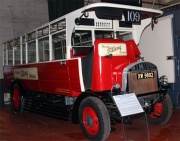Tilling-Stevens














Tilling-Stevens Motors of Maidstone pioneered a petrol-electric system of transmission for the passenger market. A petrol engine was connected to an electrical generator; the current produced passed to a motor which drove the rear wheels.
General
1897 W. A. Stevens was established in Maidstone, Kent.
1906 Built its first petrol-electric vehicle. The simpler-to-operate petrol-electric transmission was popular among bus drivers rather than the conventional crash gearbox (in the days before synchromesh) as few bus staff had previously driven motor vehicles.
1907 Contract with J. and E. Hall to convert their petrol trucks to the petrol-electric type.
W. A. Stevens was purchased by a large bus operator, Thomas Tilling; a new company named Tilling-Stevens was established.
1911 The prototype TTA1 petrol-electric bus was launched; it used a four-cylinder engine.
1911 Hadley Engineering Co was formed to bring together the various manufacturing activities for the petrol-electric vehicles on one site at Hadley but, in the end, production was carried out at Maidstone.
1913 Introduced a 40 h.p. version called TTA2.
1913-1917 For a list of the models and prices of Electric Vehicles see the 1917 Red Book
1913-1917 For a list of the models and prices of Petrol Motor Commercial Vehicles see the 1917 Red Book
WWI: Tilling-Stevens consolidated its position with bus operators during World War I because the petrol-electric chassis was not considered suitable by the Army for use in France. During the war, many men were trained to drive vehicles with conventional gearboxes which led to a decline in popularity of Tilling-Stevens’ system. Tilling-Stevens also produced a goods chassis, available with either petrol-electric or conventional petrol engines, and built many trucks during the War.
After the war, the company failed to invest in updating their products.
1919 Tilling-Stevens was voluntarily wound up and a new company, Tilling-Stevens Motors was set up in its place[1]
1919 Public company.
1920 Issued a booklet 'Electric Arc Welding' detailing their repair plants.
1920 October. Exhibited at the Commercial Motor Exhibition at Olympia with electric transmissions for petrol-electric vehicles. Also showed a 40 h.p. chassis for a single-deck omnibus.
1930 Acquired Vulcan Motor and Engineering Co of Southport, Lancashire in 1930 to extend their range (and use Vulcan petrol engines). Production stayed at Maidstone and during the World War II they specialised in searchlight trucks.
1937 Introduced eight-cylinder 7,450 cc (90 b.h.p. at 1,650 rpm governed) horizontally-opposed diesel engine to maximise payloads.
WW2 Produced searchlight lorries for the Army.
In 1950 the company was sold to Rootes Group; whole-vehicle production ceased soon afterwards. The plant continued to produce light commercial engines and vehicle bodies, before finally closing in the 1970s, some years after the group had been acquired by Chrysler.
1961 Manufacturers of diesel engines and transmission units-gearbox and front and rear axles. 900 employees. [2]
Buses
Lorries
Produced the TS3 and TS4 before WWI
See Also
- 1913 Automotor: Index
- 1916 Motor, Marine and Aircraft Red Book: Companies
- 1917 Motor, Marine and Aircraft Red Book: Electric Vehicles
- 1917 Motor, Marine and Aircraft Red Book: Petrol Motors
- 1919 Roads and Transport Exhibition
- 1920 Motor, Marine and Aircraft Red Book: Electric Vehicles
- 1920 Motor, Marine and Aircraft Red Book: Petrol Motors
- 1921 Commercial Motor Exhibition
- 1921 Royal Agricultural Show
- 1922 Who's Who In Engineering: Company T
- 1930 Industrial Britain: Tilling-Stevens
- 1950 British Industries Fair: Companies T
- 1950 Makes and Models of Road Vehicles
- 1953 Who's Who in the Motor Industry: Companies T
- 1954 Commercial Motor Show
- 1961 Dun and Bradstreet KBE
- 1961 Guide to Key British Enterprises: Motor Engines and Components for the Motor Industry also Parts for Agricultural Machinery, Garage Equipment, etc
- 1968 Who's Who in the Motor Industry: Companies
- 1971 Who's Who in the Motor Industry: Companies
- Automobile Engineer: 1924/06
- Automobile Engineer: 1937/12
- Automobile Engineer: 1938/06
- Automobile Engineer: 1938/06: Diesel Engine Makers
- Automobile Engineer: 1939/06
- Automobile Engineer: 1939/06: High-Speed Oil Engine Makers
- Automobile Engineer: 1948/08
- Birmingham and Midland Motor Omnibus Co
- Charles Edward Burton
- Charles Joseph Becker
- Coles Cranes
- Engineering 1939 Jan-Jun: Index: General
- Foamite Firefoam
- Frederick Arthur Goodman
- Frederick Henry Patterson
- Hadley Engineering Co
- Hallford
- Henry J. Coles
- Herbert Charles Reddrop
- Herbert William Witney
- Mather and Crowther
- Pagefield
- Percy Frost Smith
- Percy Harry Frost Smith
- Redwing Omnibus Co
- Rootes Group
- Sydney Dawson Begbie
- The Basic Industries of Great Britain by Aberconway: Chapter XXIV
- The Engineer 1911/11/24
- The Engineer 1912/12/06
- The Engineer 1913/05/30
- The Engineer 1913 Jul-Dec: Index: Miscellaneous
- The Engineer 1919/04/18
- The Engineer 1919/11/28
- The Engineer 1920/10/29
- The Engineer 1921/07/08
- The Engineer 1921/10/28
- The Engineer 1925/04/24
- The Engineer 1926/03/26
- The Engineer 1926/04/30
- The Engineer 1927 Jul-Dec: Index
- The Engineer 1937 Jul-Dec: Index
- The Engineer 1939 Jan-Jun: Index
- The Engineer 1949 Jul-Dec: Index
- Tilling-Stevens: B10A
- Tilling-Stevens: Buses
- Tilling-Stevens: K Series
- Tilling-Stevens: L Series
- Tilling-Stevens: TS3
- Tilling-Stevens: TS6
- Tilling-Stevens Motors
- UK Manufacturers: Road Vehicles: Internal Combustion: Pre-WWI
- Vulcan Motor and Engineering Co
- Vulcan Motor and Engineering Co: Lorries
- Vulcan Motors
- W. A. Stevens
- William Henry Joseph Norburn
Sources of Information
- ↑ London Gazette 25 November 1919
- ↑ 1961 Dun and Bradstreet KBE
- Buses and Trolley buses before 1919 by David Kaye. Published 1972
- The Engineer of 29th October 1920 p424
- The Engineer of 27th Feb 1920 p208
- [1] Wikipedia
- The Modern Diesel edited by Geoffrey Smith. Published by Iliffe & Sons 1944

